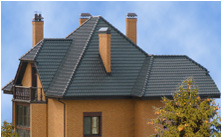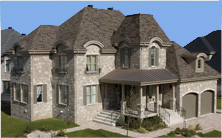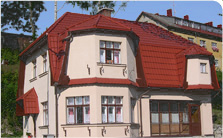Metal roofing
Metal roofing
How do you think you better protect your home - ceramic or metal roof? In any case, when comparing the tables of common and individual characteristics of any roofing, it turns out that the metal roofs of today are the panacea for all the possible problems associated with the occurrence, with injuries, the weather conditions. Metal roofing today is widely used as coatings for low-rise houses and cottages for a new multi-storey building of residential and public buildings, as well as production facilities, including a complex shape of the roof.
In the literature frequent classification, in which the metal roof belongs to the leaf (or single-piece) material. Today, it is not entirely correct, since there are new modern technology rolled metal roofing.
Three basic types of metal roofing:
• flat (or with a few ribs) cover sheet or rolled steel, made by seam technology;
• coverage of the profiled sheet and its variants that mimic shingles (metal);
• a special group selected from the roof of non-ferrous metals.
In order to select the desired type of metal roofing, it is necessary, above all, to have information about metals used to manufacture the latest and the advanced polymer coatings applied to these metals.
Metal used for metal roof.
Otsinkovannaya roofing steel has traditionally been and remains in Russia, one of the most common roofing materials. This is relatively inexpensive, easy-to-work material can arrange with the geometry of the roof of almost any complexity. Sheets of galvanized steel are also used for device eaves, wall gutters and downpipes for the roofs of other materials.
Galvanized steel coated on both sides of a layer of zinc, which protects it from corrosion. Non-galvanized steel subject to corrosion, it is short-lived, require regular maintenance and, therefore, as a roofing material is now almost never used.
Roofing uses cold-rolled galvanized steel. Getting hot dip galvanized steel - a complicated continuous process. The basis used cold-roll steel. First, it is cleaned and then annealed and galvanized in a bath of molten zinc. The thickness of the zinc deposited on both sides of the steel strip is adjustable. Roofing thickness of zinc is as a rule, 250 -320 g/m2.
Roofing is most often used steel 0,5 mm thick. At the same time on the Russian market there is a metal and steel 0,4 mm. In the process of installation and operation with it must be handled carefully. For slopes, eaves and gable overhangs, and details of drainpipes is better to use thicker steel - 0,6 mm.
As the roofing material is also used, called Aluzinc (Aluzink) (products of the Swedish company SSAB). Aluzinc is a thin steel sheet that is protected is not pure zinc and aluminum and zinc alloys. The protective layer contains 55% aluminum, 43.4% zinc and 1.6% silicon. But not only galvanized steel and aluzinc applied to the device roofs are also used non-ferrous metals.
Coatings.
To make the decorative properties of metal roof and extra protection against corrosion apply special coatings. They are used in the West for over 40 years and distributed very widely. Steel roofs coated established themselves as a high quality and durable material.
Deposition of polymer coatings on galvanized steel - is a complex process that requires full automation and quality control at every stage of production chain. Steel tape is the pretreatment step, fosfatatsii, priming, and only then applied polymer coating. Drying is carried out in a special chamber.
Galvanized steel sheet with a polymer coating has a multilayer structure: steel sheet, zinc layer, a layer of soil, and finally, the underside of the leaf - the protective paint, and the front side - the layer of colored polymer. Each component of a multilayer structure carefully selected and performs its function. For the consumer should be aware that different polymer coatings are characterized by different resistance to UV radiation (color retention), to temperature (heat resistance), aggressive media, mechanical damage and other factors.
Folded ROOF.
Called the folded roof of sheet and rolled galvanized steel and roofing made of nonferrous metals.
Seamed roof - it's metal roof, in which the compounds of individual elements of coating (painting) made with folds.
Painting - the element of roofing, whose edges were prepared for the seam compound. Seam (seam connection) - view the joint formed when the compound sheet metal roofing. Distinguish seamed connection recumbent and upright, single and double. Long side edge bands were going along a slope, band standing seam, and the horizontal - bumps. Folds are satisfied (rolled) or manually by special tool or a modern way - with special electromechanical devices seamers.
The most leak-proof and waterproof is a double standing seam - a longitudinal joint, protruding above the plane of the roof between two adjacent roof paintings, the edges of which have a double bend.
To date, folded roof in Western countries is mainly performed using the double standing seam. In Russia, the leading firms that use Western equipment, also switched to this type of compound roof paintings. And today's construction market, a large number of companies offering the device on the roof with modern technology. Unfortunately, to check whether they are really modern, in advertisements is not easy. The complexity of the roof structure is in a high percentage of the hidden works, errors that occur only in the operation of the roof. Known examples where the construction of roofs unprofessional singers led to the need for complete replacement of the roof covering.
Shaped (Blue) Sheets.
To increase the rigidity of sheet metal, they are profiling, ie, giving wave-shaped. Profiled, or, as they are called, corrugated (wavy) sheets, decking is made from galvanized steel as coated, and without it. Waves on the sheets can be high and low and have a trapezoidal, sine wave or a rounded shape.
Profiled sheets are different:
• the shape and height of the corrugations;
• the width of the finished profile;
• the terms of use.
Sheets up to 20 mm, usually used as decorative elements, without the strength calculation - boarding ceiling, internal and external walls, fences. Sheets of height greater than 20 mm are structural elements, their use should be confirmed by the calculations of the strength and deflection. Manufacturers usually specify design parameters in the catalogs. Promising to use high (120 mm) profiles as elements of permanent formwork in high-rise construction.
As a roofing material, corrugated sheets are most often used on large objects in industrial and civil construction. At present, makes it possible for the use of steel with polymer coating, which gives a large decorative sheets, the latter have been increasingly applied in the individual and low-rise construction (houses, small shops, gas stations, kiosks).
A variety of profiled sheets are different poperechnognutye and arched profiles. They significantly extend the capabilities of architects can create curved, decoration products wall corners, eaves and roof ridge.
To obtain poperechnognutogo profile sheet is bent in a special way at an angle of 900 to the direction of the profile, and the bending can be single and double. As a result of construction, before demanding more details from the seal or folded connections with transverse bending can be solved by a practical, elegant and aesthetically acceptable manner.
Arched profiles are profiled sheets, bent into a smooth flowing arc. Rounding may be convex and concave. Each range has its own carrying capacity depending on the type of profile and the distance between the supports. The arched profile can be used in structures such as, for example, cantilever roofs, galleries, awnings or curved surface roofs. With the help of arch profiles, you can get easy design with a fairly high load capacity - framed with a span of 18m or more.
Metal .
Among the roofing materials have been widely used in recent times, one of the first places in popularity is tselnolistovaya metal. It is a kind of corrugated galvanized steel sheet with a polymer coating that undergoes cross-stamping to get the picture imitating the natural tile. Metal roofing is made of coiled coils of galvanized steel coated with the polymer. Producers buy this steel (already coated) in metal processing facilities and the method of rolling steel roller and subsequent cold forming receive metal roofing.
Scope.
Metal roofing is used for both new construction and renovation. It looks particularly at her low-rise homes, small public facilities such as cafes, shops, etc., as well as temporary structures - bus stops, kiosks.
It is essential that when repairing old roofs are not necessarily dismantle the old coating. Moreover, end-of roofing materials from the roofing, flat iron, etc. can be used as an additional waterproofing. However, to avoid corrosion should avoid direct contact of galvanized steel and bitumen. Metal roofing is not recommended for roofs with a slope of less than 140.
Types of metal.
Range delivered to the market of metal, different profile geometry (width and height of waves, tile patterns, etc.), types of polymeric coatings, color palette.
For the production of metal as the front layer of polymer coating, the following polymer materials: polyester, plastisol, Pur and PVF2. Some manufacturers also offers metal roofing, which has coverage of the facial layer consists of silica sand with a special binder. This makes the material to form an even more similar to ceramic tiles, although it is considerably more expensive.
The color palette of metal, which offers manufacturers, is very diverse. It is defined by a palette of paints manufacturer sheet. Typically, each plant has its own system of marking paints. When choosing colors is recommended to use directory of flowers of this firm or samples of steel. Metal can have any traditional shades of red tiles, brown or copper patina of the old noble green roofs made of copper, as well as cutting-edge metal color - ultramarine, metallic, etc.
Advantages and disadvantages of metal:
The main advantages of metal roofing include:
• low weight;
• Easy installation;
• A variety of colors;
• long service life;
• a complete set of components supplied by firms with roofing material;
• environmental safety;
• affordable price.
One of the drawbacks of metal is often referred to increased noise in the rain and wind. But, in fact - is the lack of a roof unit. When the work was carried out qualitatively, when the wind is not knocking on the metal crate, and if done correctly drain noise flowing streams of water will not hear the tenants of the attic.
Metal is a material whose quality is highly dependent on the quality of the source material (galvanized steel and coatings), process equipment, and fasteners.
ROOF-ferrous metal.
As a roofing material, the following non-ferrous metals: copper, aluminum and zinc-titanium alloy (D-zinc). Most prevalent among the roofs of non-ferrous metals to date received copper. Zinc-titanium alloy is also gaining popularity.
Copper roofing
Copper roofs are well known to us through the majestic buildings of the past. In Russia, there was a period when the copper roof has been unjustly forgotten and almost never used. But today, there were firms that have revived the tradition of copper for roofing work, and using the latest technology.
Copper - a brilliant silvery substance with a slight pinkish hue, which acquires a reddish color to the extent of contact with air. Copper, which we usually see, has a reddish color. It is the color of copper oxide formed by the interaction of metal with air.
During the first year of service from the copper becomes first reddish brown, and then a dull black. This color has its natural oxide. Over time, the oxides change color to malachite green, but this requires at least 15-20 years. There are artificial ways of patinated copper, giving a similar result at once, for example, before laying, but they are expensive. Patina is a natural protective coating of copper, reliably protect it from corrosion and deterioration. We can say that under the patina of copper is almost invulnerable. This fact directly affects the work-life copper roof, counted not in decades, hundreds of years. Copper is resistant to dilute acids, caustic alkalis, sea, fresh potable and industrial waters, dry gases and other media. Its melting temperature is 1083 0C.
Copper is perfectly amenable to welding, which makes repair coverage simple and reliable, it uses tin copper. Also applies time-tested way of soldering or tinning, known since ancient years, when tin is used. It is important to note that the presence of mechanical damage does not require replacing the entire sheet or strip, you just cut a copper patch and weld (or soldered) joints. Patched very quickly covered with a patina, and the differences renovated space will be very difficult, and when seen from earth - is impossible.
The natural plasticity of copper gives another important advantage - a copper tape or sheet can easily cover any roof, even the most complex and intricate configurations, all bends are overcome very simply and quickly.
Quality criteria of copper tape is the stability of the geometric dimensions (thickness and width), which is a consequence of a very high level of production technology and strict quality control rolling.
The main advantages of copper roofs.
The unique properties of copper make it a great roofing material, which is on a whole range of factors and properties has no equal. The main advantages of copper roofs are as follows:
• The longest life span.
At the heart of the phenomenal longevity of copper roof is high chemical resistance of the metal. Becoming covered under atmospheric conditions with a thin and durable layer of oxide-patina, she serves faithfully at least 100-150 years.
• No operating costs.
Packed fresh new copper roof in the future does not require any care and supervision - it should not have cleaned and painted.
• Environmentally friendly.
Copper roof will never rust, no flaking, it is completely neutral to the environment, metal is not only absolutely harmless, but it also has anabolic properties.
• Maintainability coverage.
Even under the most serious mechanical damage copper roofing is easily repaired, since brass is plastic and easily soldered.
• The beauty, grace and prestige.
Copper roofing is beautiful always - and just piled, reddish-colored metal that glistens in the sun, and served for a year or two, a noble bronze-brown, and soon the matte black, and finally was old - bright green, while remaining in such a state of the century. Perhaps the only drawback is its copper roof is high enough price, which, however, is consistent with the quality of this material.
Aluminum roof.
Aluminum is used as for the manufacture of metal, and device seamed roofs.
Алюминиевая металлочерепица изготавливается из рулонного металла, на который уже нанесены необходимые покрытия. Ее отличает малый вес (около 2 кг/м2), что позволяет применять ее почти на всех обрешетках крыш. Алюминиевая металлочерепица обладает высокой долговечностью, цветостойкостью, практически не подвержена атмосферным воздействиям.
Кровли из титан-цинкового сплава.
Кровельный материал из цинк-титанового сплава (D-цинк) малоизвестный пока в России давно распространен в Европе. Современный материал на основе цинка (Цинк-титан) представляет собой цинк, легированный титаном и медью. Возможностью формовки, пластичностью и способностью к пайке материал напоминает медь, при этом он почти в два раза дешевле ее.
Он отличается высокой коррозионной стойкостью и абсолютной экологической безвредностью, недаром в быту широко применяется сделанная из него посуда. Кровли из цинк-титанового сплава не требуют ухода и срок их службы практически равен сроку службы здания, а их благородная красота снискала любовь архитекторов во всем мире.
Источник: Полина Личагина / idh.ru





